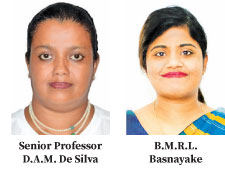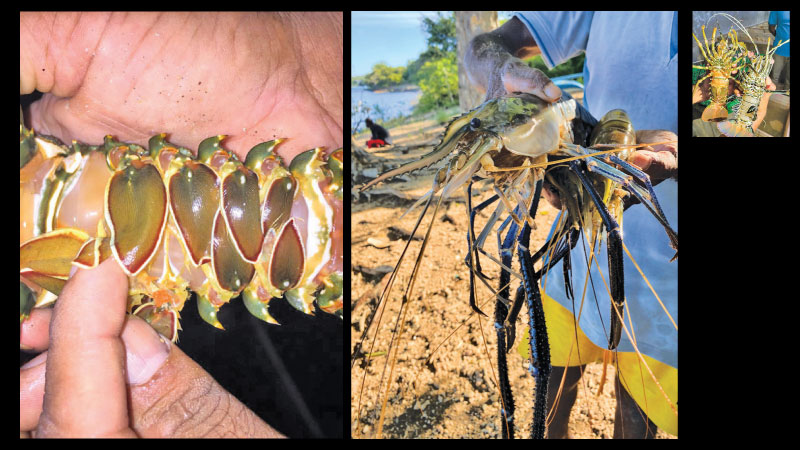In a country where seafood is esteemed in culinary traditions, a recent study sheds light on the evolving consumer preferences and behaviours surrounding two high-value seafood commodities: lobster and Giant Freshwater Prawn (GFP) (also called lake lobster).
 Our study examines how consumers choose between lobster and GFP, the problems fishers face, and how the industry can improve. It also explores how people’s sustainability awareness shapes the seafood market.
Our study examines how consumers choose between lobster and GFP, the problems fishers face, and how the industry can improve. It also explores how people’s sustainability awareness shapes the seafood market.
Lobster and GFP are primarily harvested for export, with significant destinations including Japan, Hong Kong, China, and the UK. Local consumption remains limited, with high-end restaurants and tourist hotels being the main buyers. Improving handling and transportation is essential with the increasing demand for live seafood and top-quality products.
However, the supply of lobsters is limited due to the overexploitation of this resource, which is coupled with growing demand. Similarly, the supply of GFP is restricted due to a lack of freshwater prawn seeds, and the strategy for cultivating GFP has not been implemented scientifically.
An online survey was conducted among 280 lobster and 430 GFP consumers in Sri Lanka from August to mid-October 2024. The lobster fishing industry operates in southern, eastern, western, and northern coastal areas. The Hambantota District in the Southern Province stands out as the leading producer of spiny lobster, contributing over 60% of the total national harvest.
Similarly, significant reservoirs across Sri Lanka support aquaculture production and GFP harvesting. The most active provinces for GFP fishing are the North-Central, Northern, Sabaragamuwa, and Southern provinces, where harvesting primarily focuses on export markets. However, the leading exporters and key seafood markets are concentrated in the Western and Southern provinces, particularly in tourist areas with many hotels and restaurants.
Challenges in supply and fishing restrictions
Lobster and GFP fishing in Sri Lanka is primarily done by small-scale fishers using traditional methods. Lobsters are caught using skin, scuba diving, and nets, while GFP is harvested from reservoirs. One of the biggest challenges for lobster fishers is the seasonal ban from September to November and in February, which allows lobsters to breed. Although this ban helps protect the species, it creates financial difficulties for fishers, leading some to fish illegally.
Additionally, the identified challenges include social insecurity, life risks associated with diving, absence of specific gear for lobster fishing, impacts of climate change, low catch levels, catching egg-bearing or undersized animals, an increasing number of non-fishers, price fluctuations, and the monopolistic power of exporters.
In the GFP industry, market monopolies mean that a few collectors control pricing, leaving fishers with little power to negotiate better deals. Further, poor post-harvest handling and poor internal transportation, discontinuity of stocking, lack of market information, absence of specific fishing gear, lack of research and development interventions, damage to nets by wildlife, high competition from other countries and water level fluctuations are identified as other key challenges. Further, as shown in the above figure, if the head is damaged, the quality deteriorates rapidly, and the collection is not purchased. Those animals are sold to local village consumers for a very cheap price.
Exporters also dominate both industries, setting prices and managing logistics. However, concerns about food safety and sustainable fishing practices remain without proper tracking and certification systems.
What do consumers think?
Consumer preferences play a significant role in shaping the market. A survey study conducted among 280 lobster consumers and 430 GFP consumers in Sri Lanka reveals a stark contrast between the purchasing behaviours of lobster and GFP. Both consumers prioritise affordability and are willing to pay a premium for certified, high-quality products if they are available in the market. This suggests a growing awareness among Sri Lankan consumers about food safety and sustainability in seafood sourcing.
GFP buyers tend to be more price-conscious and prefer sustainably certified products. They look for size, taste, and affordability, often choosing smaller prawns, believing they have better flavour. On the other hand, lobster buyers focus more on appearance and freshness rather than sustainability. Many are unaware of the overfishing problem or the struggles fishers face due to seasonal bans.
In high-end restaurants, foreign consumers prefer live lobsters, believing they taste better. However, ethical concerns about transporting live seafood remain a topic that needs more attention. Raising consumer awareness about sustainability and responsible seafood consumption could benefit the industry in the long run.
Moreover, the study also highlights consumer perceptions of economic equity among fishers. While GFP consumers show moderate awareness and support for rural farming communities, lobster buyers display limited knowledge of coastal fishers’ financial challenges, particularly regarding seasonal bans and income instability.
Solutions for a sustainable future
Several changes are needed to ensure fishers’ stable income and protect marine resources. First, improving cold storage and handling methods can enhance product quality and market value. Fishers could also benefit from working together in cooperatives, giving them more power in pricing negotiations. Investing in value-added processing and giving fishers better market access can improve profitability in the GFP sector.
These findings further suggest the need for more substantial consumer education initiatives and policy interventions. Experts recommend the introduction of eco-labeling and improved traceability systems to enhance consumer confidence and promote sustainable fisheries. Proper labeling can attract environmentally conscious consumers by positioning these products as “wild-caught” or “free-range.”
Effective branding and packaging are essential to compete in premium markets. Additionally, enforcing international food safety standards could boost Sri Lanka’s seafood exports while catering to the rising demand for responsibly sourced seafood.
Government support is also crucial. Providing financial assistance to fishers during the fishing ban period and strictly enforcing regulations on illegal harvesting will help balance economic and environmental needs. With growing international demand for high-quality seafood, Sri Lanka has an opportunity to strengthen its position in the global market. Addressing key challenges in the supply chain, improving awareness of sustainability issues, promoting ethical consumption, and adopting modern fisheries management practices will be essential to ensure the industry’s long-term viability.
The lobster and GFP industries in Sri Lanka face many challenges, including overfishing in lobster fisheries, market control by a few big players, and poor handling and transport. However, more consumers are starting to care about sustainability and food safety.
By improving storage and transport, providing better market access to fishers, and raising awareness about sustainable fishing, Sri Lanka can strengthen its seafood industry. Collaboration between industry leaders, policymakers, and research institutions is key to ensuring a more substantial and sustainable seafood industry.
By Ms. B.M.R.L. Basnayake,Lecturer, Faculty of Agricultural Sciences, Sabaragamuwa University of Sri Lanka
Senior Professor D.A.M. De Silva, Faculty of Agricultural Sciences, Sabaragamuwa University of Sri Lanka









